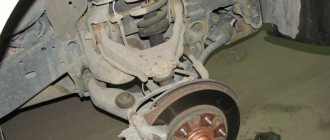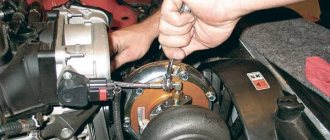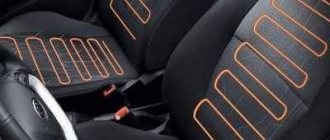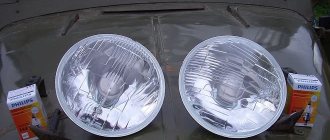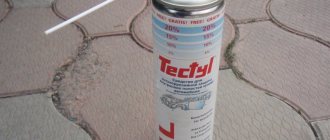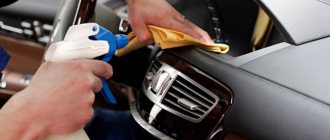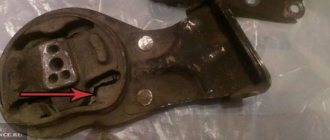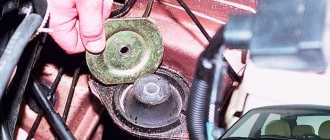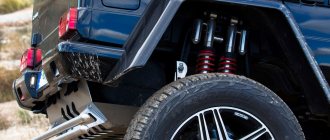The operating power unit of any car is subject to a complex combination of loads:
- Reactions from the transmission of torque to the drive wheels;
- Horizontal forces when starting, sharp braking and clutch operation;
- Vertical loads when driving over uneven surfaces;
- Vibration vibrations, the strength and frequency of which change in proportion to the change in crankshaft speed;
- Own weight of the engine assembled with the gearbox.
The main part of the load is taken by the frame (body) of the car.
High-frequency vibrations of audible frequencies penetrate into the cabin, disturbing the comfort of the driver and passengers. Low-frequency vibrations are felt by the skin and body, which also does not add comfort to the trip.
Car owners combat sound frequency fluctuations by installing additional sound insulation.
Only serviceable engine mounts can soften and suppress low-frequency vibrations.
Torn engine mount: signs
Like any other part, the power plant support also has a limited service life and eventually fails.
On average, airbags on modern cars are designed to last at least 100-120 thousand km, although in practice these elements may need to be replaced both earlier and much later than this period. Usually the cause of problems is the rubber insert, which simply cracks and breaks under load. Less often, cracks appear in the metal part of the support, the installation sites of fasteners are broken, etc.
One way or another, the following symptoms usually indicate a malfunction of the engine mounts:
- The engine itself runs smoothly, but the driver feels a clear increase in vibrations in the body, on the steering wheel, on the gearshift knob, etc.;
- When you start moving from a standstill, as well as during braking, you can hear clicking or muffled knocking in the engine compartment;
- When driving on an uneven road, impacts are heard from the front of the car; in many cases such impacts are felt on the gearshift lever; shifting gears with a manual transmission at this moment can be difficult;
To check the engine mounts, it is not necessary to immediately go to a service station and drive the car to a stand. Usually, a fault can be identified and localized on your own, even if you do not have much experience in car repair and maintenance.
The simplest method of initial diagnosis is to rock the engine with your hands in the engine compartment, after which you can localize a torn or cracked support by knocking.
Another technique for diagnosing engine mounts is when the hood is first opened and fixed, then the car is started and jerked forward in first gear. The car moves backwards in the same way. At this time, an assistant outside monitors the vibrations of the internal combustion engine.
To carry out a more detailed check, you first need to find out in advance where exactly the supports are located on a particular model. Then the elements available for review will need to be pre-inspected. Cracks, breaks and other damage are usually visible and easily visible.
For a full visual assessment of the lower airbags, you need to be prepared for the fact that the car will need to be parked in a garage with an inspection hole, driven onto an overpass, or using a lift.
If a superficial diagnosis shows nothing, then the assistant should be used again. One person uses a pry bar to move the support, while the other watches for tears in the rubber insert at the very moment the support moves. It happens that some cracks are not immediately visible without rocking.
After detecting a torn engine mount, the damaged element should be replaced. It is not recommended to try to press the rubber insert out of the cylinder in order to save on spare parts, since such makeshift repairs often do not bring the desired results.
As for the replacement itself, replacing the top cushion is quite simple. The car needs to be jacked up, the old cushion removed and a new one installed.
If you have to change the lower supports, it is also important to consider that the engine goes down after removing this cushion. This means that an additional support will be required that supports the internal combustion engine, allowing you to direct the pillow and correctly secure this element
How to determine whether the supports are working or not?
There are several ways to independently check the status of these devices. You can try to rock the engine with your hands. By knocking on a certain side, it is easy to localize the faulty mechanism. Another common diagnostic method is when the hood is opened and locked, the engine is started, after which the car jerks forward and backward. This way it will be possible to determine whether the unit is moving and returning to its original position with a knock.
Hydraulic cushions can crack, which will cause leakage of working fluid from the system. Supports with damaged rubber gaskets are unsuitable for further use and should be replaced as soon as possible. It is easy to identify mechanical damage and defects, for example, separation of the rubber part from the metal, at the time of maintenance of the power unit. Any destruction of the pillows is a strong argument in favor of replacing them with new, original copies. In order for the new kit to fully exhaust its service life, you must follow a number of simple steps:
- periodically check the tightness of nuts, bolts, and other fasteners;
- remove traces of engine oil and dirt from the surface of the supports;
- operate the vehicle calmly and moderately;
- prevent any critical loads on the engine or chassis of the car;
- use original supports or analogues from trusted manufacturers.
It turns out that operating a car without vibration and vibration dampers is simply impossible. That is why it is important to monitor their condition and replace them in a timely manner. Now the range of products on the market of spare parts and components for cars is incredibly diverse. Car owners often face difficulties in choosing new supports and understanding their average cost from different manufacturers. In such cases, you can use services that will show the average cost of engine mounts in your region.
Domestic drivers, according to reviews, give preference to German products (the production of pillows is carried out by the German company FEBI , which produces high-quality products at an affordable price). Many automobile concerns already install devices from SWAG - another manufacturer from Germany that relies on multi-level quality control. Engines of French cars come off the assembly line with airbags from SASIC - the optimal solution for those who spend time driving Peugeot, Citroen, Renault.
How to replace an engine mount
How and when to change the valve of the VAZ 2105-07 stove
It is necessary to replace the engine mounts in a heated box or garage (at least in the warm season), since working with rubber elements in the cold will be complicated by an increase in the rigidity of the material as a result of exposure to cold air. To make work easier, the car should be placed on an inspection hole or overpass. To avoid a short circuit, remove the terminals from the battery.
The location of the supports and their mounting options depend on the vehicle. In some cases, the operation is not difficult; in others, on the contrary, getting to the elements is quite problematic. Let us describe the process of replacing engine mounts using the example of a VAZ-2110.
Replacing the right engine mount.
To perform the replacement, you need a set of tools and accessories, including a jack, a set of keys, and repair supports. The vehicle will need to be raised using a jack and supports installed. Then you should slightly raise the power unit using a wooden plank placed between the jack and the crankcase protection. The board will help distribute forces and minimize the risk of deformation of the pallet
During the process of lifting the internal combustion engine, it is important to monitor the radiator and fan shroud.
Through bolts are used to secure the supports to the frame. After removing the bolts, dismantling the old pillow will not present any difficulties.
After replacing the engine mount, it is necessary to assemble the parts in reverse order.
It wouldn’t hurt to treat the bolt threads with lubricant, then it will be easier to unscrew it next time.
Replacing the left engine mount.
After replacing the right engine mount, you need to check the condition of the left mount. It minimizes vibrations from the transmission. The jack must be moved from under the power unit to the box, put a board under it and lift it a little. This removes the load from the cushion, making it easier to dismantle. To do this you will need a 15mm socket wrench and an extension. First of all, unscrew the support stud nut and remove the upper stop.
To remove the stud, you need to lower the transmission slightly. To secure the support to the body, two 13mm bolts are used. After unscrewing them, the cushion can be moved towards the internal combustion engine. After this, you need to remove the upper limiter. Installation is carried out in reverse order. The main thing is that the pin fits exactly into the oval hole of the gearbox bracket, otherwise it will begin to rotate, which will not allow it to be tightened.
Replacing the rear engine mount.
The rear engine support is collapsible, which allows you to purchase the element itself without a bracket. However, assessing the condition of the old mount is extremely important; the presence of cracks and other signs of wear will indicate the need to replace the engine mount assembly.
Replacement of the rear support is carried out according to the previously described algorithm. The nuts securing the supports to the body and transmission are removed. The cushion is dismantled and the condition of the bracket is assessed. If there are no signs of wear, then you can purchase a support without fastening.
To replace the engine mount, you need to secure the bracket with a vice, unscrew the central nut, remove the support, then install a new one and tighten the nut. Install the cushions in the engine compartment in the reverse order.
Replacing the front engine mount.
The front support wears the most. Its failure threatens with strong vibrations coming to the body. When the first signs of a malfunction appear, it is worth replacing the engine airbag. The operation is quite simple, involving unscrewing the nuts securing it to the body, removing the support and installing a new one, assembling the parts in the reverse order.
Foreign cars usually have a similar number of supports, differing in size and shape. This difference is especially noticeable in the front airbag. The more densely the components and assemblies of the internal combustion engine are arranged, the more parts will have to be dismantled to replace the airbag.
After replacement, the engine must be started. Correctly carried out repair work will be characterized by minimal vibration or its complete absence. The appearance of strong vibration after replacing the engine mount will require re-checking the correct installation of parts and the quality of their fastening.
However, vibration after replacing engine mounts may be caused by other reasons.
We begin to remove and install the front hydraulic mount on the Ford Focus 2 2.0 liter engine.
- We drive the car into the pit.
- Unscrew the engine protection.
- We jack up the engine so that the right support is unloaded.
- We remove the expansion tank. To remove it, simply pull it off and move it to the side, since it will interfere when unscrewing the support.
- We take a 15 socket and unscrew the two nuts securing the support bracket itself, which is attached to the side member of the car.
- Using a 18mm head, unscrew the two nuts of the rubber mount itself, which is attached to the engine.
- Carefully, so as not to damage it, pull out the air conditioner tube, which is attached to the support on top with a rubber clamp.
- We install the new support in reverse order.
After some time, I dismantled the old front support of a Ford Focus 2 2.0 liter engine. Watch a short video:
As we see, there is nothing complicated in replacing the front right engine mount on a Ford Focus 2. You can do all this yourself and with your own hands. This concludes my short note about the front right engine mount of the Ford Focus 2. Dear reader, if you have any questions about me or to this note. A small request to leave your comments.
Replacing the engine mount if a malfunction is detected
How and when to change antifreeze in a car: period or mileage
If you need to replace the engine mounts, the signs of malfunction described above will usually allow you to get to the nearest car service center or your own garage on your own. But you should drive carefully, if possible at a speed no higher than 60 km/h. The rear or left cushion is usually subject to wear. A detected malfunction of one support will most likely entail the replacement of the second pillow. At the end of the inspection, you need to purchase the necessary spare parts in advance - you won’t be able to go get them by car while replacing the airbags.
Preparing to replace the engine mount
It is recommended to carry out work on replacing supports in a warm place, since the rubber used at low temperatures hardens and loses elasticity. This will significantly complicate the process.
It is also advisable to drive the car into an inspection hole and carry out the replacement from there, having first disconnected the battery terminals. They often begin to inspect the left front side of the engine, where the airbag malfunction appears in most cases and access to which is most convenient.
A torn mount can be repaired, since the price of a new mount for a foreign car engine is about 2,000 rubles (and for an SUV it is twice as high). If the rubber element is damaged, the support will have to be changed in any case.
Engine mount replacement process
First of all, protective elements are removed from the motor to facilitate access to the necessary parts. A jack is then placed under the engine to provide support while the mounts are removed. If the process takes place in a viewing hole, you can lay a wide, fairly strong board across it and install a jack on it.
Next, the unit is raised with a jack until it is possible to freely unscrew the support being replaced. After unscrewing the mounting screws and removing the old support, a new one is installed in its place, and the operation is repeated in the reverse order.
Replacing a rear airbag is usually associated with certain difficulties. This support experiences the greatest loads during engine operation. As a result, all fasteners are deformed, including bolts. The shape of the fastener differs from other supports.
Here a jack will no longer be enough. To free the support, it is best to hang the motor from the upper beam. If this is not possible, you can build a crossbar on two glasses, lifting the engine with a jack in advance. In some car models, external components may interfere with troubleshooting and will have to be removed. It is more efficient to cut off a severely deformed pillow fastening bolt with a cutting wheel. Sometimes they try to align and unscrew such a bolt, but after a while it will still have to be replaced.
The old support often sticks to the frame and forms rust due to the accumulation of dirt. Oil or a product like WD-40 can help remove it.
It is important to install the new rear support correctly. The arrow on the support should point forward, in the direction of travel of the machine. The rest of the assembly is carried out in reverse order.
After replacing the rear support, you can proceed to the right
Here, too, there is a possibility of encountering deformed bolts, but a more serious problem lies in the generator or car air conditioning compressor located here. It is known that removing the compressor can lead to depressurization of the circuit and leakage of refrigerant.
If the repair takes place at a service station, it is better to subsequently check the air conditioner for possible malfunctions. Short-sighted car service employees sometimes remove the compressor themselves to save time, without warning the car owner about it.
In foreign cars, in most cases, the right engine mount is located closer to the front. Therefore, to access this cushion, the right headlight and radiator grille are often removed.
Some of the deformed bolts cannot be cut off even with a grinder, since access to them is limited by other neighboring elements or simply cannot be reached. In this case, it is better to use a regular hacksaw, cutting off the damaged bolt by hand.
This procedure will take much longer, but at least this way you will not damage adjacent parts and components. The new support is placed in place of the old one as usual, in reverse order. When installing the radiator grille, you need to be careful - the radiator honeycombs are sharp enough to cut yourself.
Safety at work
The most important thing is to fix the motor securely and safely. A second assistant is desirable for assistance and backup.
Features of operation
If excessive engine vibration occurs, check the integrity of the engine mount.
The engine mount is a part subject to wear, as it always works when the engine is running. The greatest challenge for the supports is starting the engine, moving away, and stopping the car. At such moments, the load on the supports is greatest. Wear or failure of this part increases the load on the engine and increases the likelihood of engine failure.
Cracks and tears in the support cushion are visible if a routine inspection is specifically carried out for this purpose, but symptoms such as increased vibration with feedback to the steering wheel when the engine is running or shifting gears with jerks, and if the cushion near the gearbox wears out, it can knock out the speed. Here the obvious facts are clear, you need to buy a set of new supports in order and start replacing.
Having a set of keys at hand, the jack and the inspection hole can, in principle, be changed independently without special skills, although there are cases where the procedure for replacing engine mounts is a very amusing matter.
It is not difficult to monitor the condition of rubber-metal supports: you just need to check the integrity of the rubber gasket and regularly remove dirt and oil from it, and tighten the fastening bolts.
If your vehicle is equipped with hydraulic mounts, you must open the hood and start the engine to test them. Next, you need to drive a couple of centimeters forward and backward. If there is something wrong with the supports, the engine will move out of place when starting and return to place when stopping, which will be accompanied by clearly audible sounds.
Regardless of which support cushions support the engine on your car, the advice is the same for everyone. You should not crash sharply, thereby putting maximum load on the supports, cross potholes and humps at low speeds, so that engine vibrations are minimal, and therefore the vibrations that need to be absorbed by the engine mounts will not be significant.
Subscribe
to our channel in
Index.Zen
Even more useful tips in a convenient format
Engine mount, support structure
How often to change the engine air filter
The number of support points is determined by the direction of the engine location inside the body and the calculation of a team of engineers from a particular manufacturer, so there can be four or more pillows.
The main criterion when choosing points is the reliability of the fastening and the low probability of the motor moving to the side. As a rule, the motor, assembled with the gearbox into a common block, is mounted in two or three places at the top and in three or four places at the bottom. In modern transport, two main types of cushions are used - hydraulic and rubber-metal.
The design of rubber-metal supports is simple. The lower supports are metal plates with a rubber cushion between them. The upper supports are created in the form of a short suspension arm with silent blocks, the first side of which is attached to the body bracket using a through bolt, and the second to the bracket, which is attached to the cylinder block. This type of support is most widespread due to its low cost of production and reliability.
Some designs of the lower support cushions are reinforced with springs to increase elasticity and add rigidity. Some manufacturers use polyurethane instead of rubber as a more wear-resistant material. Cushions using polyurethane are also often used on sports cars to increase rigidity.
As a result of the emergence of fashion for tuning, some companies have started producing polyurethane supports for the most current vehicle models. Also, polyurethane and rubber-metal supports are classified according to non-removable and collapsible design.
Hydraulic supports are a more progressive mechanism. Such supports are able to adapt to different engine speeds and effectively suppress vibrations at any speed. The supports consist of chambers with a membrane between them. These chambers are filled with special hydraulic fluid or propylene glycol (antifreeze).
The movable membrane is able to dampen vibrations when the engine is idling. When driving on uneven roads or at high speed, the hydraulic fluid begins to work. Through special channels under pressure, it makes the support rigid, flowing from one chamber to another. A rigid support can dampen strong vibrations.
There are hydraulic supports:
- Mechanical control. This design is calculated individually for each car model. Even at the stage of development of a specific vehicle model, it is decided what purpose the support will be used for - effective damping during fast driving or comfortable noise insulation while the engine is idling.
- Electronic control. Such supports respond to changes in the vibration mode of the motor within wider limits. The hardness of the airbag is changed electronically depending on the situation on the road. Hydraulic mounts of this type are new generation mounts that provide optimal comfort when the engine operates in various modes.
Type of power unit supports
For each model, automakers select power unit mounts with the best performance properties. All samples are tested on stands and during actual sea trials. The accumulated experience of large-scale production allows us to use cushions of the same design in machines produced on common platforms for years.
All pillows (supports) of modern cars can be divided into two groups according to their design:
- Rubber-metal. Almost all mass-produced and budget cars are equipped with them.
- Hydraulic. Used in cars of higher and premium classes. In turn, they are divided into:
- passive, with constant performance characteristics;
- active, or controlled, with changeable properties.
Diagnostic methods
Signs of wear on engine mounts
- Engine vibration at idle.
- Extraneous knocks while driving, felt in the engine compartment or under the gearbox.
- Jerks during dynamic acceleration of the car.
- Knocks in the engine compartment when starting or stopping the engine.
- Difficulty shifting gears.
On cars with hydraulic supports, in addition, acceleration dynamics may deteriorate. Visually, faulty airbags can be identified by delamination and ruptures of rubber dampers or breakage of aluminum brackets. An experienced specialist can also visually identify a sagging pillow by how severely its damper is deformed.
Types of pillows
Despite the variety of design options, the general purpose of the cushions is to act as an engine mount, i.e. dampen vibrations and vibrations of the power unit. The role of an engine damper is usually played by rubber (sometimes in interaction with the hydraulic properties of the oil), absorbing shocks and vibration, while preventing displacement of the power unit.
As an example, we can take the motor mount on the Niva. It is a rubber cylinder with plates with threaded rods welded to it. The left and right engine mounts are absolutely identical, the third, which supports the gearbox, has a slightly different appearance and is mounted on a crossbar mounted on the bottom of the car.
The dimensions of the supports and their attachment points are designed in such a way as to prevent displacement of the power unit, while the weight of the engine compresses the cushion, and is distributed in such a way that rupture of the rubber due to its shear deformation is practically eliminated. In a similar way, the engine, also located longitudinally to the axis of the car, was installed on " Volgakh".
But with a transverse engine arrangement, it is somewhat more difficult to balance it, due to the design of the power unit as a whole. Therefore, the supports most often take the form of suspension arms, which have silent blocks as an engine damper, as on the additional supports of the VAZ 2112: This design of supports is also sometimes caused by the need to support the points of the engines most distant from the body, which after modernization have acquired a large mass.
The use of additional supports allows you to install heavier engines without significant changes to the design of the car. The most typical method for relatively small power units is the method of “hanging” them, as on 2108 -09. The engine assembly with gearbox has three mounting points:
- left engine mount;
- rear (lower) engine mount.
How do engine mounts work?
The cushions work similarly to the silent blocks of the suspension arms, that is, they twist the rubber. Therefore, on cars driven primarily on bad roads, because... such supports turn out to be unreliable - the rubber delaminates. More compact cars, which are relatively heavy (in relation to the total weight of the car), are suspended somewhat differently - the rubber damper in them works in compression-tension, which increases its service life.
Hydraulic (or hydromechanical) engine mounts differ from conventional ones in that they have variable stiffness. This is achieved by taking vacuum from the engine. When a certain number of revolutions is reached, the valve separating the support chambers closes.
DETAILS: Changing the oil in Volkswagen Golf 5. Changing the oil of Volkswagen Golf 5 with your own hands
As a result, the liquid (antifreeze), which previously flowed from chamber to chamber, begins to play the role of an elastic element. Externally, such supports differ mainly in the presence of a fitting for connecting a vacuum hose and cable. Such cushions are intended to dampen vibrations from the motor, the bulk of which “lies” on other supports.
So, the owner believes that the engine mount has failed. The symptoms of the malfunction were confirmed. Next, you need to check the condition of the supports. In order to ensure the integrity of these parts, you will need a jack and any supports - wood stumps, pallets, tires.
Anything will do. It is also advisable to prepare a crowbar or a thick stick. Let's look at how to determine if an engine mount is faulty. To do this, it is recommended to place the car on the most flat surface possible. Then the car needs to be lifted using a jack, then a prepared support should be installed under the engine. It could be a log or something else. It's better to remove the jack.
We determine the condition of the supports visually
The above signs will not always indicate a malfunction of the engine mounts. So, if impacts are observed in the front part of the body, you need to visually inspect the element. We already know where he is. So, open the hood and look at the condition of the rubber buffer.
There should be no breaks or cracks on it. For better convenience, it is recommended to use an inspection hole (especially if it is a front and rear support). Move it from side to side. There should be no play between the cylinder and the silent block. If so, signs of engine mount failure have been confirmed. The part must be replaced.
Types and types of engine mounts
Before checking anything, it is also necessary to understand the purpose of the part, what malfunctions of the element may occur, as well as what signs of failure. As you know, the engine weighs quite a lot and vibrates during operation. This means that if the internal combustion engine is rigidly attached to the car body, then all vibrations will be transmitted to the latter.
When driving over uneven surfaces, the mounting points of the power unit experience significant loads. A rigid attachment to the body will mean that the fasteners and their installation location will quickly begin to break. To ensure that the overall design is reliable and comfort is maintained, special supports are used to mount the internal combustion engine.
If you open the hood, you can immediately see the top (right support). The rest are located on the underside of the motor. Again, placement points depend on the car model, engine and gearbox type. In most cases, engine mounts consist of a rubber housing and metal fasteners.
Sometimes polyurethane is used instead of rubber, which is more wear-resistant. In expensive cars, more complex and modern options are installed - hydraulic ones. The vibration damping efficiency is naturally much higher.
Such supports consist of two chambers, between which a membrane is located. Either propylene glycol or a special liquid (gel) is used as a filler in the chambers. During operation, depending on road conditions (for example, on uneven surfaces), it flows from one chamber to another through special channels, and the overall rigidity of the cushion dynamically changes thanks to this design.
There are different types of hydraulic supports:
- Electronically controlled. The computer changes the rigidity of the support by receiving and processing signals - vibrations, the strength of which changes depending on the situation. The liquid inside such a pillow often contains metal particles and the density changes under the influence of a magnetic field. Thanks to such technologies, it is possible to achieve maximum comfort in the car interior, regardless of engine operating mode and road conditions;
- With mechanical control. A simpler option. Technical characteristics are set at the assembly stage. It depends on them in what mode the maximum benefit will be: at idle or at different engine operating modes.
Of course, high-tech devices are installed on very expensive cars. On budget options, and even more so on old Soviet models, simple rubber-metal supports are installed. In case of breakdown or wear (usually they last about 100,000 km), they are simply replaced. And the hydraulics can be repaired. And even on your own. However, before removing the mounts, you need to know how to check the engine gel mount, rubber mount, etc.
Engine mount with hydraulic mounts
The power unit is attached to the body on elastic supports
.
They absorb vibrations so that they are not transmitted to the body and do not become sources of unpleasant noise in the cabin. In addition, the supports protect the engine from sudden shocks when the car moves on uneven roads. The most common and cheapest option is rubber-metal supports. The name speaks for itself: two plates and a rubber spacer between them. Sometimes, for greater rigidity, springs are installed inside the cushions, and buffers are installed to soften impacts. Such rather simple elements do not effectively dampen vibrations over the entire operating range of the engine. Hydraulic mounts
react more flexibly to changes in speed . At minimum speeds, the cushion must be soft to effectively dampen vibrations. As the speed increases when the car moves, the amplitude of vibrations increases - in this case it is necessary for the engine mount to become stiffer. The operating principle of the hydraulic support resembles conventional shock absorbers. The vibrations are dampened by the working fluid flowing from one chamber to another. They are filled with propylene glycol (popularly known as antifreeze). With small movements of the power unit (engine idling), the vibrations are smoothed out by a movable membrane - a soft support dampens engine vibrations transmitted to the body. The crankshaft revolutions and speed increase, and along with them the amplitude of vibrations also increases. The membrane can no longer cope with the increased load, and the throttle device comes into operation. Under pressure, liquid flows through its channels from the upper chamber to the lower one - the rigidity and energy intensity of the support increases.
The operating principle of a modern hydraulic mount with mechanical control:
a) at idle, soft support:
1 – lower (expansion) chamber; 2 – throttling channel; 3 – upper (working) chamber; 4 – movable membrane; 5 – hydraulic support body; 6 – damping fluid channel.
b) in motion, rigid support:
in motion, support is rigid
Hydraulic mounts for each engine model are configured separately. The performance characteristic is set by changing the diameter and length of the channel of the throttling device. There are options for “pillows” with electronic control; they are more complex in design, but respond faster to changes in modes. For example, let's take supports with an electric vacuum drive. The engine control unit receives information from the crankshaft position sensor, takes into account the vehicle speed and supplies power to the solenoid valve of the pipeline running from the intake manifold to the support. The resulting vacuum pulls out the damper membrane and opens a channel through which liquid flows from the upper chamber to the lower one - in this case the cushion is soft. The engine speed has risen, the car has moved off - the electronics close the vacuum channel and connect it to the atmosphere. The vacuum in the support drops, under the influence of atmospheric pressure the membrane rises up and closes the hole between the upper and lower chambers. The only path left for the liquid is through the spiral channels of the throttling device. At the same time, the resistance increases, and accordingly the rigidity of the cushion increases, which allows it to effectively withstand vibrations of greater amplitude - for example, when driving on an uneven road.
Operating principle of an electronically controlled hydraulic mount:
a) at idle, soft support:
1 – damper membrane; 2 – lower (expansion) chamber; 3 – throttling channel; 4 – upper (working) chamber; 5 – hydraulic support body; 6– spiral channel of the throttle device; 7 – fitting for supplying vacuum.
b) in motion, rigid support:
in motion, support is rigid
There is a similar design with electronic control, but without a vacuum line. At minimum speeds, the channel connecting the air cushion cavity with the atmosphere is open. When the power unit oscillates, the working fluid flows freely from the upper chamber into the cavity above the air channel and back. In this case, the membrane easily bends and displaces excess air out. When moving, the solenoid valve closes the channel connecting the air cavity with the atmosphere. The rubber membrane of the air chamber stops bending, and liquid begins to seep from the upper to the lower cavity through the throttling device.
Source
How much does it cost to change engine mounts in a car?
If you go to a car repair shop to replace a mount or even want to carry out the procedure yourself, you are, of course, interested in how much it costs to change engine mounts
But to understand pricing, it is important to understand exactly how the replacement takes place, what the scope of work is.. Firstly, special tools and, of course, the parts themselves are needed to carry out the work
Secondly, when working with engine mounts, it is important that the room where the work takes place is warm, since the rubber does not tolerate low temperatures when replacing: in the cold it will stiffen and will not allow you to adjust the position of the engine. Thirdly, in order to carry out repairs or replacement, the car will need to be driven into an inspection hole.
Firstly, to carry out the work you need special tools and, of course, the parts themselves
Secondly, when working with engine mounts, it is important that the room where the work takes place is warm, since the rubber does not tolerate low temperatures when replacing: in the cold it will stiffen and will not allow you to adjust the position of the engine. Thirdly, in order to carry out repairs or replacement, the car will need to be driven into an inspection hole.
First, all protection is removed from the engine, and it itself is raised and securely fixed in this position with a jack. After these manipulations, the specialist can begin repair work.
The left cushion is inspected first, then all the pillars are gradually checked and their condition is assessed. A torn cushion mount must be repaired, which is much cheaper than a complete replacement of the entire left engine mount.
The rack, which is located on the left, is the easiest to replace. First you need to unscrew the fasteners, and then dismantle the part that is damaged. Next, a new pillow is installed. The fastest thing to change is the front engine mount.
But the rear airbag is more difficult to repair and replace. The fact is that it bears most of the load when the car is moving, so often the bolts that secure the support are deformed, and unscrewing them can be very problematic. If this fails, you have to cut them down (manually or with a grinder). To carry out such work you need to have experience. After all, one wrong move can damage the generator and air conditioning compressor, which are located nearby.
Next, the right support is replaced, for which the right headlight and radiator grille are removed. When access is open, you can remove the damaged part by first cutting off the bolts with a hacksaw. Here, again, you need to act carefully because of the closely spaced radiator fins, which have sharp edges.
There are cars (for example, Lada Priora), where the engine mount has an element often called a “guitar”.
The top support is easy to change due to its location and ease of access.
Of course, if you have some experience and knowledge in the field of car design and repair, you can carry out all the above-described manipulations yourself, having previously purchased the necessary spare parts in the store.
This will require skill and time on your part. You will probably need an assistant to insure you while you work. In addition, you will have to look for a suitable place to carry out the work. But you will save money.
But if the issue of money is not very pressing, it is still better to entrust the replacement of engine mounts to professionals who can handle the job in a couple of hours or even less. Still, even in such not the most complex work, nuances are possible. Plus they will give you a guarantee.
You can change engine mounts for 2,000 rubles or more - it all depends on the model of your car. As a rule, the service center gives a discount if you have to change all the pillows at once.
We independently change the front right hydraulic engine mount on a Ford Focus 2 car
Hello dear readers of my short note.
I would like to share with you and tell you about the front right engine support (mount) on the Ford Focus 2, 2.0 liter engine. Draw small conclusions for yourself and not repeat mistakes. Be more scrupulous in studying the question posed regarding the repair or replacement of a particular part on a car. All's well when all's well ends. These are not my words, but the people's.
As you know, I recently changed the lower engine mount on a Ford Focus 2 2.0 liter engine. and 145 hp automatic transmission. insert link. Before replacing parts on cars, as always, it is necessary to collect all the information on this problem.
Without any embarrassment, read the forums about this car. There are very competent specialists and car owners on the forums. In my case, I always read technical literature, what car repair luminaries write there. I have a Ford Focus 2 and I, like many car owners of these cars, go to the forum known among Ford owners as the Ford Club.
Do you think I listened to the guys who have been using Ford Focus 2 cars for a long time. What are you talking about, we ourselves know everything. Yes, I won’t lie, it’s just that the “toad of stinginess” was choking me. Why change two supports on the car at once.
After all, the front right support (hydraulic support) is working and I have not observed any fluid leaks. I think my old support will last for several thousand kilometers. Yeah, that was not the case. Having replaced the rear support, I left the garage. There was no vibration. Gear shifting became softer.
Engine hydraulic mount: how is it designed, how to diagnose it and can it be repaired?
It is a rare modern engine that does not rest on hydraulic cushions under the hood in order to minimally disturb the driver and passengers with its vibrations. What are the benefits of such supports, when did they appear in the automotive industry, how will they evolve and... when will they disappear?
The fact that the oscillating parts of the mechanism need to be vibration-isolated from the stationary ones was clear to the ancient Romans, who already in the first century BC figured out how to hang the “body” of the cart from a chassis with wheels on belts made of thick shock-absorbing leather. In the automotive industry, rubber dampers for installing an engine on a chassis were introduced by Walter Chrysler in the late 1920s, initially for Plymouth models. Vibration isolation was a good competitive advantage, so technology even came up with the marketing name Floating power. In Europe, the pioneer in the introduction of rubber dampers was Citroen, which bought the rights to the technology from Chrysler to implement it in the Traction Avant design.
For many decades, the rubber engine mount remained one of the most conservative parts of any car, and its evolutions were extremely subtle. And these days there are still quite a few cars driving on the roads (UAZs, Volgas, Moskvichs), whose engine support cushions are the simplest monolithic rubber block or disk...
In principle, to prevent engine vibrations from destroying the steel frame of the body and causing chronic seasickness in the driver, these primitive rubber “chocks” are quite sufficient. However, the growing requirements for comfort inside the car gave rise to some of their development - engineers played with the shape of dampers, made sandwiches from rubber of different elasticity, and included steel springs in the structure. This bore fruit - the supports began to work in a wider range of vibrations and loads: at loads of different strength and direction, different elements of the rubber modules were included in the work, providing, when necessary, increased elasticity or, conversely, increased rigidity:
However, in the mid-80s of the twentieth century, European automakers began to introduce rubber-hydraulic engine mounts into their models. Thus, one of the first cars to use hydraulic support was the Mercedes-Benz W124. Unlike purely rubber ones, they damped vibrations in a wider range of frequencies and amplitudes, acting on the principle of a shock absorber - damping vibrations due to the resistance of the liquid forced through calibrated throttling holes.
Possible reasons
The reasons for premature failures are as follows:
- Tuning using stiffer shock absorbers, installing low-profile tires in order to improve handling and change the appearance of the car. Stiffer shock absorbers do not completely absorb body vibrations; they are transferred to the suspension and cushions. Low-profile tires also increase the load on the cushions, as they absorb less well.
- Driving style with standing starts, sharp turns, braking and skidding. It causes increased loads on the engine mounts and provokes a movement of the center of gravity; repairs will be required faster.
- Racing on rough roads without reducing speed also destroys all shock-absorbing mechanisms.
- Don't forget about natural wear and tear. Loads and temperature changes, aging of rubber and filler that loses elasticity.
and automatic transmission
Novice car owners often wonder why the automatic transmission jerks when driving. There are many reasons for this. Can the automatic transmission jump due to faulty engine mounts? Yes maybe. Sometimes the car's behavior changes. Therefore, if extraneous vibrations, shocks, hums, or characteristic noise are noticed, then it is best to check the supports.
Engine mount
– a fastening device with which the power unit is mounted on a vehicle.
In addition to the function of fastening, it functions as a pillow. For this reason, the support is often also called engine mount
, and in English it sounds like engine mount. Also, depending on the design, the support may be called a “guitar”, since the shape resembles this musical instrument.
As a rule, not one, but several (most often three) supports are used. Their task is to absorb vibrations from the running motor and keep it in the most static position. Since it will definitely vibrate during operation, and this fact does not depend on the degree of its power and perfection. Mounting the engine on a cushion support not only improves ride comfort, but also protects the power unit from impacts and jolts when moving over uneven surfaces.
Initially, the supports were simple metal fasteners that rigidly pulled the engine to the supporting structure. In fact, only the engine mount bracket in the modern sense was used. Then rubber cushions were added to the mechanism, increasing the elasticity of the mount, making it possible to provide a more elastic motor suspension. This type of rubber-metal engine mount is still widely used today.
Typical faults
If the car is operated for a long time under conditions of severe loads or temperature changes, then all this does not have the best effect on the condition of the engine mounts. Over time, rubber loses its elasticity. In addition, the pillow may delaminate or crack, or even collapse. But it is worth considering that the service life of these parts is quite long - more than 100,000 km. The supports are subjected to high loads when the vehicle starts and during braking. If the car owner likes to drive fast enough, with sharp jerks at the start, then the supports will not last their intended period. Also among the typical faults is the breakdown of a metal aluminum bracket. This often happens when hitting a different obstacle. If there are oil leaks in the engine, it will definitely get onto the rubber part of the support. This lubricant can corrode the silent block and the support will fail. Coolant also does not have the best effect on the rubber part of the cushion. Breakdowns in the system must be eliminated immediately.
Not In addition to a cracked cylinder head, antifreeze from the expansion tank will also get onto the rubber parts. This will not have the best effect on their resource. It is important to remember that operating vehicles with broken mounts is not only unpleasant, but in some cases unsafe.

